 Technology peripherals
Technology peripherals
 AI
AI
 ST-P3: End-to-end spatiotemporal feature learning vision method for autonomous driving
ST-P3: End-to-end spatiotemporal feature learning vision method for autonomous driving
ST-P3: End-to-end spatiotemporal feature learning vision method for autonomous driving
arXiv paper "ST-P3: End-to-end Vision-based Autonomous Driving via Spatial-Temporal Feature Learning", July 22, author from Shanghai Jiao Tong University, Shanghai AI Laboratory, University of California San Diego and JD.com Beijing Research Institute.
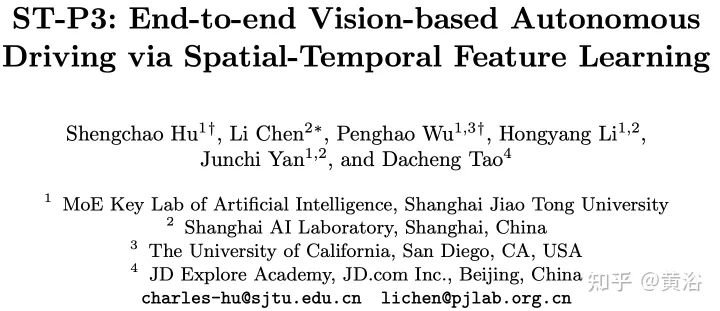
Propose a spatio-temporal feature learning scheme that can simultaneously provide a set of more representative features for perception, prediction and planning tasks, called ST-P3. Specifically, an egocentric-aligned accumulation technique is proposed to retain the geometric information in the 3-D space before sensing BEV conversion; the author designs a dual pathway model to Past motion changes are taken into account for future predictions; a time domain-based refinement unit is introduced to compensate for planned visual element recognition. Source code, model and protocol details open sourcehttps://github.com/OpenPerceptionX/ST-P3.
The pioneering LSS method extracts perspective features from multi-view cameras, lifts them to 3D through depth estimation, and fuses them into BEV space. Feature conversion between two views, whose latent depth prediction is crucial.
Upgrading two-dimensional planar information to three dimensions requires additional dimensions, that is, depth suitable for three-dimensional geometric autonomous driving tasks. To further improve feature representation, it is natural to incorporate temporal information into the framework since most scenes are tasked with video sources.
Described in the figureST- P3Overall framework: Specifically, given a set of surrounding camera videos, input them into the backbone to generate preliminary front view features. Performs auxiliary depth estimation to convert 2D features into 3D space. The self-centered alignment accumulation scheme first aligns past features to the current view coordinate system. Current and past features are then aggregated in three-dimensional space, preserving geometric information before converting to BEV representation. In addition to the commonly used prediction time domain model, performance is further improved by constructing a second path to explain past motion changes. This dual-path modeling ensures stronger feature representation to infer future semantic outcomes. In order to achieve the ultimate goal of trajectory planning, the early feature prior knowledge of the network is integrated. A refinement module was designed to generate the final trajectory with the help of high-level commands in the absence of HD maps.

The picture shows the self-centered alignment accumulation method of perception. (a) Utilize depth estimation to lift the features at the current timestamp to 3D and merge into BEV features after alignment; (b-c) Align the 3D features of the previous frame with the current frame view and fuse with all past and current states, Thereby enhancing feature representation.

As shown in the figure is a two-way model used for prediction: (i) The latent code is the distribution from the feature map; (ii iii) Road a It incorporates an uncertainty distribution that indicates future multi-modalities, while path b learns from past changes, helping path a’s information to compensate.
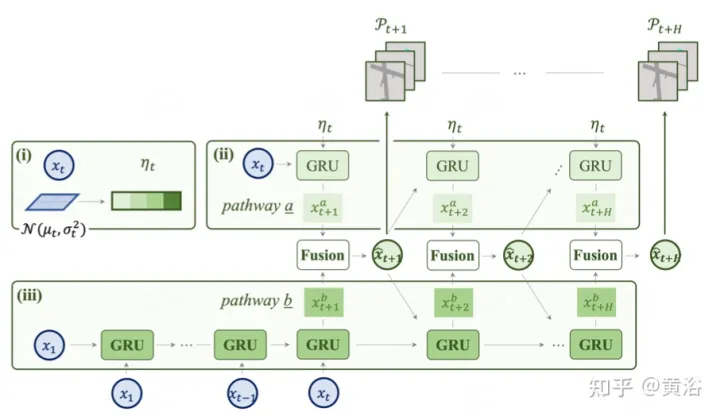
#As the ultimate goal, it is necessary to plan a safe and comfortable trajectory to reach the target point. This motion planner samples a set of different trajectories and selects one that minimizes the learned cost function. However, integrating information from target points and traffic lights through a time domain model adds additional optimization steps.
The picture shows the integration and refinement of prior knowledge for planning: the overall cost diagram includes two sub-costs. Minimum-cost trajectories are further redefined using forward-looking features to aggregate vision-based information from camera inputs.
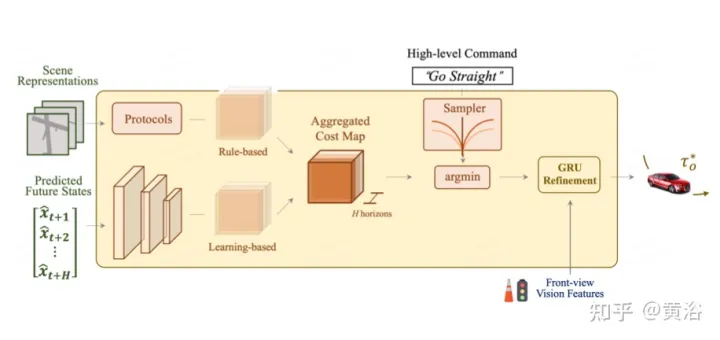
Penalize trajectories with large lateral acceleration, jerk, or curvature. Hopefully, this trajectory will reach its destination efficiently, so forward progress will be rewarded. However, the above cost items do not contain target information usually provided by route maps. Use high-level commands, including forward, turn left, and turn right, and evaluate trajectories only based on the corresponding commands.
In addition, traffic lights are crucial to SDV to optimize trajectories through the GRU network. The hidden state is initialized with the front camera features of the encoder module and each sample point of the cost term is used as input.
The experimental results are as follows:
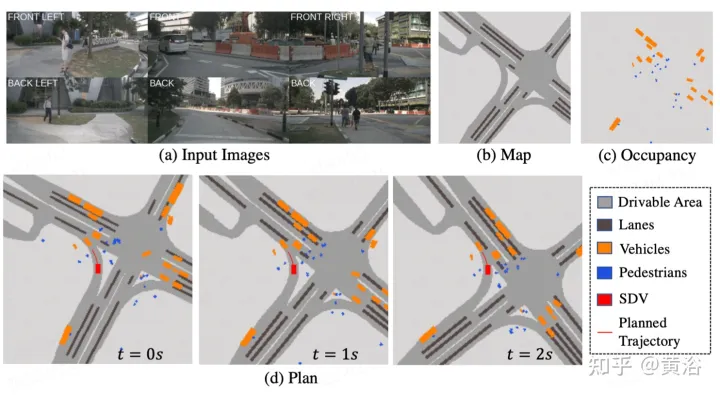

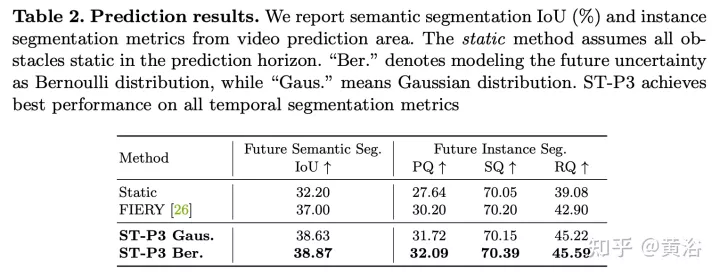

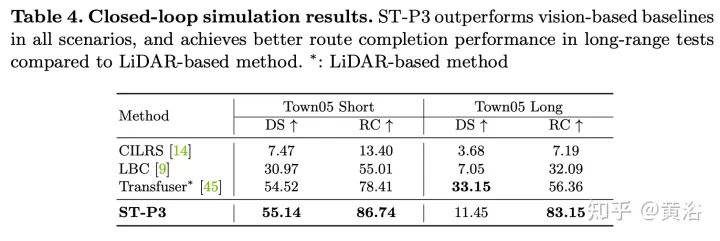
The above is the detailed content of ST-P3: End-to-end spatiotemporal feature learning vision method for autonomous driving. For more information, please follow other related articles on the PHP Chinese website!

Hot AI Tools

Undresser.AI Undress
AI-powered app for creating realistic nude photos

AI Clothes Remover
Online AI tool for removing clothes from photos.

Undress AI Tool
Undress images for free

Clothoff.io
AI clothes remover

AI Hentai Generator
Generate AI Hentai for free.

Hot Article

Hot Tools

Notepad++7.3.1
Easy-to-use and free code editor

SublimeText3 Chinese version
Chinese version, very easy to use

Zend Studio 13.0.1
Powerful PHP integrated development environment

Dreamweaver CS6
Visual web development tools

SublimeText3 Mac version
God-level code editing software (SublimeText3)

Hot Topics
 1378
1378
 52
52
 Why is Gaussian Splatting so popular in autonomous driving that NeRF is starting to be abandoned?
Jan 17, 2024 pm 02:57 PM
Why is Gaussian Splatting so popular in autonomous driving that NeRF is starting to be abandoned?
Jan 17, 2024 pm 02:57 PM
Written above & the author’s personal understanding Three-dimensional Gaussiansplatting (3DGS) is a transformative technology that has emerged in the fields of explicit radiation fields and computer graphics in recent years. This innovative method is characterized by the use of millions of 3D Gaussians, which is very different from the neural radiation field (NeRF) method, which mainly uses an implicit coordinate-based model to map spatial coordinates to pixel values. With its explicit scene representation and differentiable rendering algorithms, 3DGS not only guarantees real-time rendering capabilities, but also introduces an unprecedented level of control and scene editing. This positions 3DGS as a potential game-changer for next-generation 3D reconstruction and representation. To this end, we provide a systematic overview of the latest developments and concerns in the field of 3DGS for the first time.
 How to solve the long tail problem in autonomous driving scenarios?
Jun 02, 2024 pm 02:44 PM
How to solve the long tail problem in autonomous driving scenarios?
Jun 02, 2024 pm 02:44 PM
Yesterday during the interview, I was asked whether I had done any long-tail related questions, so I thought I would give a brief summary. The long-tail problem of autonomous driving refers to edge cases in autonomous vehicles, that is, possible scenarios with a low probability of occurrence. The perceived long-tail problem is one of the main reasons currently limiting the operational design domain of single-vehicle intelligent autonomous vehicles. The underlying architecture and most technical issues of autonomous driving have been solved, and the remaining 5% of long-tail problems have gradually become the key to restricting the development of autonomous driving. These problems include a variety of fragmented scenarios, extreme situations, and unpredictable human behavior. The "long tail" of edge scenarios in autonomous driving refers to edge cases in autonomous vehicles (AVs). Edge cases are possible scenarios with a low probability of occurrence. these rare events
 Choose camera or lidar? A recent review on achieving robust 3D object detection
Jan 26, 2024 am 11:18 AM
Choose camera or lidar? A recent review on achieving robust 3D object detection
Jan 26, 2024 am 11:18 AM
0.Written in front&& Personal understanding that autonomous driving systems rely on advanced perception, decision-making and control technologies, by using various sensors (such as cameras, lidar, radar, etc.) to perceive the surrounding environment, and using algorithms and models for real-time analysis and decision-making. This enables vehicles to recognize road signs, detect and track other vehicles, predict pedestrian behavior, etc., thereby safely operating and adapting to complex traffic environments. This technology is currently attracting widespread attention and is considered an important development area in the future of transportation. one. But what makes autonomous driving difficult is figuring out how to make the car understand what's going on around it. This requires that the three-dimensional object detection algorithm in the autonomous driving system can accurately perceive and describe objects in the surrounding environment, including their locations,
 The Stable Diffusion 3 paper is finally released, and the architectural details are revealed. Will it help to reproduce Sora?
Mar 06, 2024 pm 05:34 PM
The Stable Diffusion 3 paper is finally released, and the architectural details are revealed. Will it help to reproduce Sora?
Mar 06, 2024 pm 05:34 PM
StableDiffusion3’s paper is finally here! This model was released two weeks ago and uses the same DiT (DiffusionTransformer) architecture as Sora. It caused quite a stir once it was released. Compared with the previous version, the quality of the images generated by StableDiffusion3 has been significantly improved. It now supports multi-theme prompts, and the text writing effect has also been improved, and garbled characters no longer appear. StabilityAI pointed out that StableDiffusion3 is a series of models with parameter sizes ranging from 800M to 8B. This parameter range means that the model can be run directly on many portable devices, significantly reducing the use of AI
 This article is enough for you to read about autonomous driving and trajectory prediction!
Feb 28, 2024 pm 07:20 PM
This article is enough for you to read about autonomous driving and trajectory prediction!
Feb 28, 2024 pm 07:20 PM
Trajectory prediction plays an important role in autonomous driving. Autonomous driving trajectory prediction refers to predicting the future driving trajectory of the vehicle by analyzing various data during the vehicle's driving process. As the core module of autonomous driving, the quality of trajectory prediction is crucial to downstream planning control. The trajectory prediction task has a rich technology stack and requires familiarity with autonomous driving dynamic/static perception, high-precision maps, lane lines, neural network architecture (CNN&GNN&Transformer) skills, etc. It is very difficult to get started! Many fans hope to get started with trajectory prediction as soon as possible and avoid pitfalls. Today I will take stock of some common problems and introductory learning methods for trajectory prediction! Introductory related knowledge 1. Are the preview papers in order? A: Look at the survey first, p
 SIMPL: A simple and efficient multi-agent motion prediction benchmark for autonomous driving
Feb 20, 2024 am 11:48 AM
SIMPL: A simple and efficient multi-agent motion prediction benchmark for autonomous driving
Feb 20, 2024 am 11:48 AM
Original title: SIMPL: ASimpleandEfficientMulti-agentMotionPredictionBaselineforAutonomousDriving Paper link: https://arxiv.org/pdf/2402.02519.pdf Code link: https://github.com/HKUST-Aerial-Robotics/SIMPL Author unit: Hong Kong University of Science and Technology DJI Paper idea: This paper proposes a simple and efficient motion prediction baseline (SIMPL) for autonomous vehicles. Compared with traditional agent-cent
 nuScenes' latest SOTA | SparseAD: Sparse query helps efficient end-to-end autonomous driving!
Apr 17, 2024 pm 06:22 PM
nuScenes' latest SOTA | SparseAD: Sparse query helps efficient end-to-end autonomous driving!
Apr 17, 2024 pm 06:22 PM
Written in front & starting point The end-to-end paradigm uses a unified framework to achieve multi-tasking in autonomous driving systems. Despite the simplicity and clarity of this paradigm, the performance of end-to-end autonomous driving methods on subtasks still lags far behind single-task methods. At the same time, the dense bird's-eye view (BEV) features widely used in previous end-to-end methods make it difficult to scale to more modalities or tasks. A sparse search-centric end-to-end autonomous driving paradigm (SparseAD) is proposed here, in which sparse search fully represents the entire driving scenario, including space, time, and tasks, without any dense BEV representation. Specifically, a unified sparse architecture is designed for task awareness including detection, tracking, and online mapping. In addition, heavy
 FisheyeDetNet: the first target detection algorithm based on fisheye camera
Apr 26, 2024 am 11:37 AM
FisheyeDetNet: the first target detection algorithm based on fisheye camera
Apr 26, 2024 am 11:37 AM
Target detection is a relatively mature problem in autonomous driving systems, among which pedestrian detection is one of the earliest algorithms to be deployed. Very comprehensive research has been carried out in most papers. However, distance perception using fisheye cameras for surround view is relatively less studied. Due to large radial distortion, standard bounding box representation is difficult to implement in fisheye cameras. To alleviate the above description, we explore extended bounding box, ellipse, and general polygon designs into polar/angular representations and define an instance segmentation mIOU metric to analyze these representations. The proposed model fisheyeDetNet with polygonal shape outperforms other models and simultaneously achieves 49.5% mAP on the Valeo fisheye camera dataset for autonomous driving



